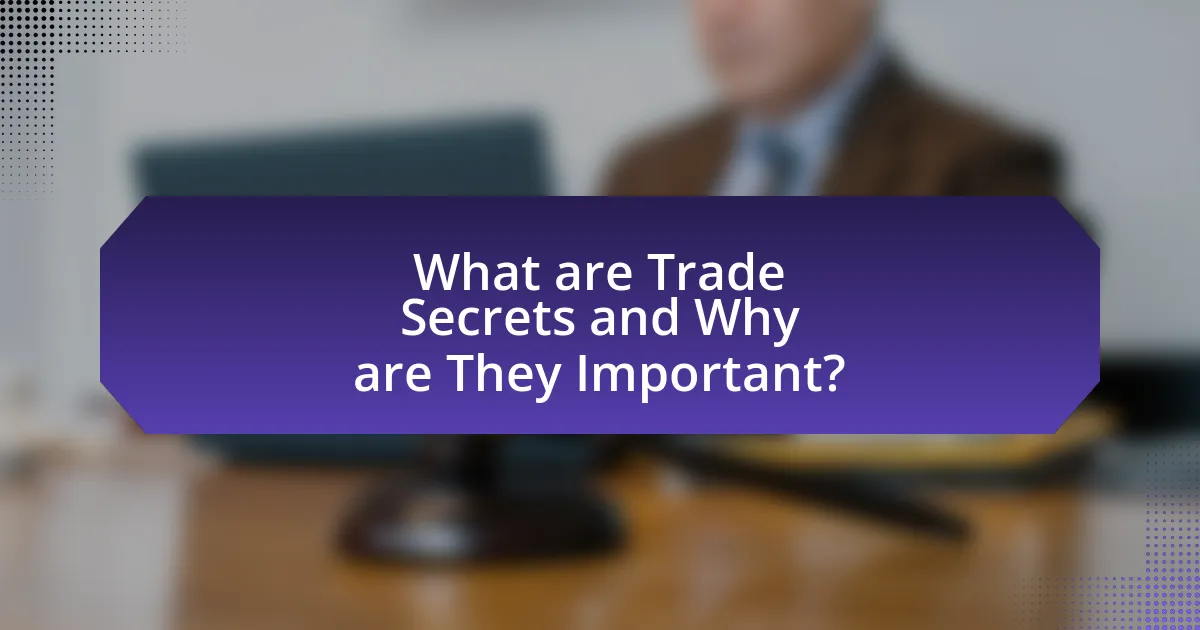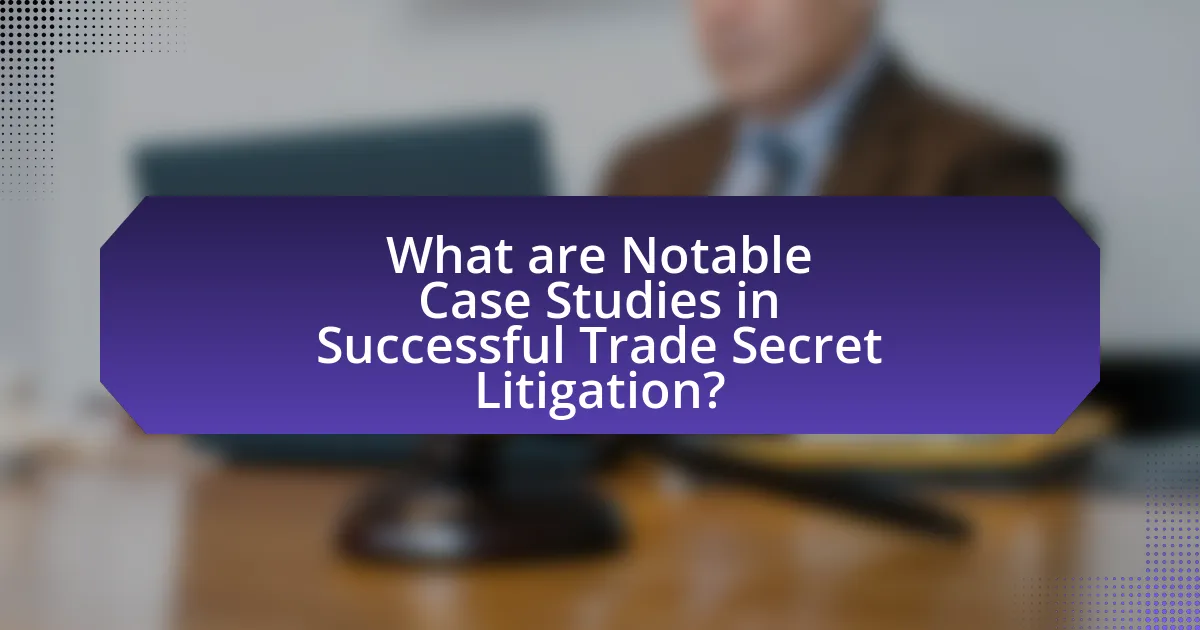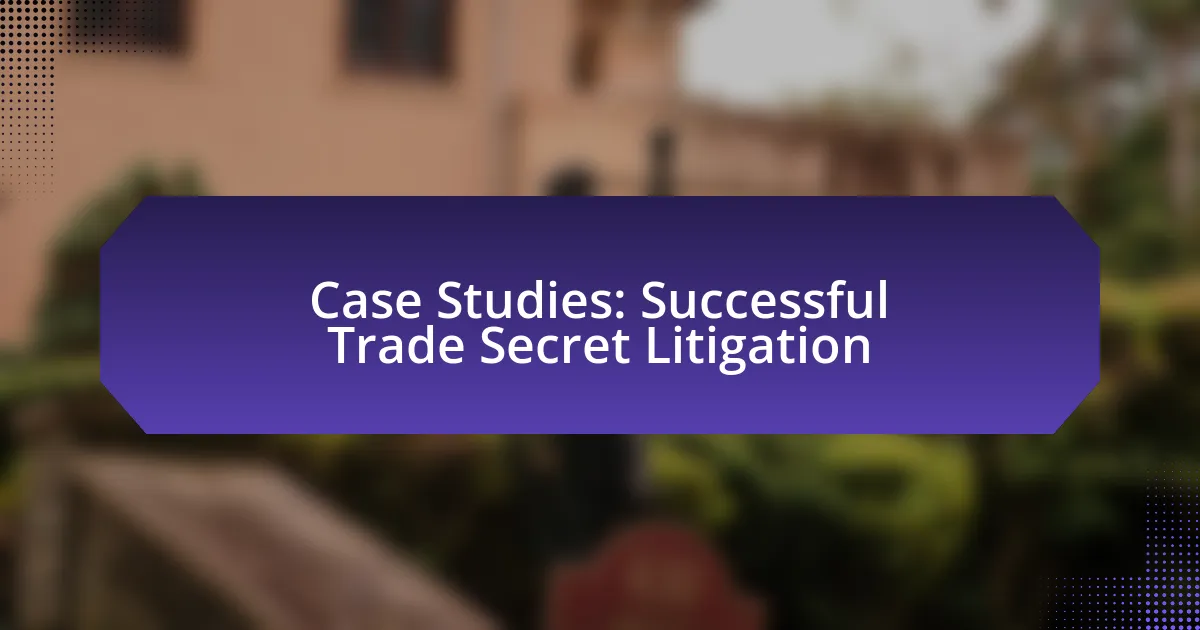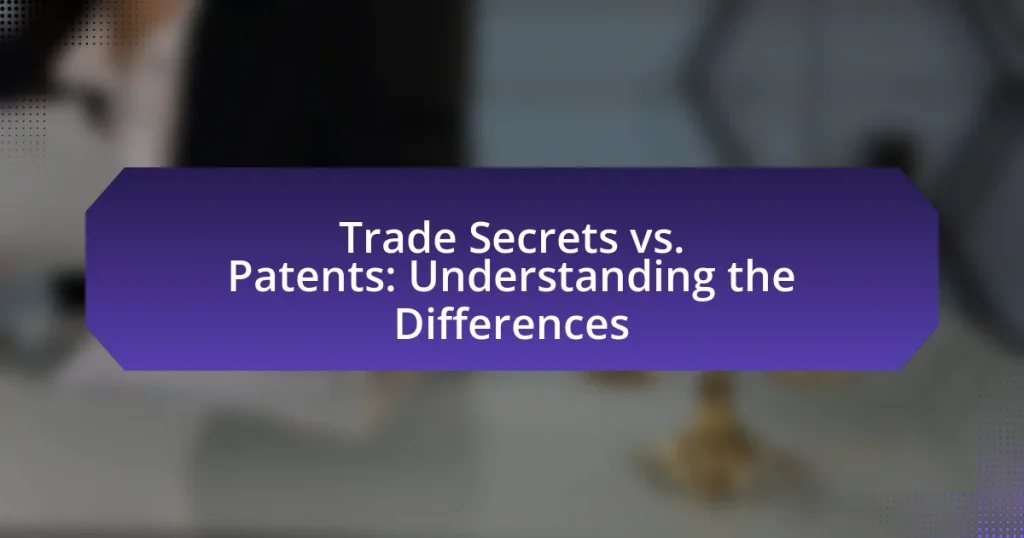The article focuses on trade secrets and their significance in maintaining a competitive advantage for businesses. It outlines the legal definitions and criteria that classify information as a trade secret, emphasizing the importance of protecting such information through various measures. The article also examines notable case studies, including E.I. du Pont de Nemours and Company v. Kolon Industries and Waymo LLC v. Uber Technologies, highlighting the outcomes and implications of these cases on trade secret litigation. Additionally, it provides practical tips for businesses on how to safeguard their trade secrets and respond effectively when breaches occur.

What are Trade Secrets and Why are They Important?
Trade secrets are confidential business information that provides a competitive edge, such as formulas, practices, processes, designs, instruments, or patterns. They are important because they help businesses maintain their market position and profitability by preventing competitors from easily replicating their unique offerings. For instance, the Coca-Cola formula is a well-known trade secret that has contributed significantly to the company’s success and brand identity. Protecting trade secrets through legal means, such as litigation, is crucial for companies to safeguard their intellectual property and ensure long-term viability in the marketplace.
How are trade secrets defined legally?
Trade secrets are legally defined as information that is not generally known or readily accessible, derives economic value from its secrecy, and is subject to reasonable efforts to maintain its confidentiality. The Uniform Trade Secrets Act (UTSA) and the Defend Trade Secrets Act (DTSA) provide the legal framework for this definition in the United States, emphasizing the importance of maintaining the secrecy of the information through measures such as non-disclosure agreements and security protocols. These legal definitions are supported by case law, which illustrates how courts have upheld the protection of trade secrets when the criteria of secrecy, value, and reasonable efforts are met.
What criteria must information meet to be considered a trade secret?
To be considered a trade secret, information must meet three criteria: it must be secret, it must have economic value, and it must be subject to reasonable efforts to maintain its secrecy. The information is deemed secret if it is not generally known or readily accessible to others who could obtain economic value from its disclosure or use. Economic value arises when the information provides a competitive advantage over those who do not know or use it. Reasonable efforts to maintain secrecy can include measures such as non-disclosure agreements, restricted access, and security protocols. These criteria are established under the Uniform Trade Secrets Act and the Defend Trade Secrets Act, which provide a legal framework for the protection of trade secrets.
Why is the protection of trade secrets crucial for businesses?
The protection of trade secrets is crucial for businesses because it safeguards their competitive advantage and proprietary information. When companies maintain the confidentiality of their trade secrets, such as formulas, processes, or customer lists, they can prevent competitors from gaining access to valuable insights that could undermine their market position. For instance, the Coca-Cola formula, a closely guarded trade secret, has allowed the company to maintain its unique product offering and brand identity, contributing significantly to its long-term success. Additionally, research from the Economic Policy Institute indicates that businesses that actively protect their trade secrets experience higher profitability and innovation rates, reinforcing the importance of such protections in sustaining a competitive edge in the marketplace.
What are the common types of trade secrets?
Common types of trade secrets include formulas, practices, processes, designs, instruments, patterns, or compilations of information that provide a business advantage over competitors who do not know or use them. For example, the Coca-Cola formula is a well-known trade secret that has been protected for over a century, demonstrating the value of proprietary information in maintaining competitive advantage. Additionally, customer lists and marketing strategies are also considered trade secrets, as they can significantly impact a company’s market position and profitability.
How do formulas and recipes qualify as trade secrets?
Formulas and recipes qualify as trade secrets when they provide a competitive advantage and are not generally known or readily accessible to others. The legal definition of a trade secret, as outlined in the Uniform Trade Secrets Act, includes information that derives independent economic value from not being publicly known and is subject to reasonable efforts to maintain its secrecy. For instance, the Coca-Cola formula is a classic example; it is kept confidential and provides significant market advantage, demonstrating how proprietary information can be protected under trade secret laws.
What role do customer lists play in trade secret protection?
Customer lists serve as critical components in trade secret protection by providing businesses with a competitive advantage through exclusive access to valuable customer information. These lists contain details about customer identities, preferences, and purchasing behaviors, which are not generally known or readily accessible to competitors. The protection of customer lists as trade secrets is supported by legal frameworks, such as the Uniform Trade Secrets Act, which defines trade secrets as information that derives independent economic value from not being generally known and is subject to reasonable efforts to maintain its secrecy. Courts have upheld the classification of customer lists as trade secrets in various cases, emphasizing the necessity for businesses to implement measures like confidentiality agreements and restricted access to safeguard this information.

What constitutes Successful Trade Secret Litigation?
Successful trade secret litigation is characterized by the effective demonstration of the existence of a protectable trade secret, the misappropriation of that trade secret, and the resulting harm to the trade secret owner. To establish a protectable trade secret, the owner must show that the information is not generally known or readily accessible, derives economic value from its secrecy, and is subject to reasonable efforts to maintain its confidentiality. Misappropriation occurs when someone acquires the trade secret through improper means, such as theft or breach of a confidentiality agreement. The harm can be quantified in terms of lost profits, market share, or competitive advantage, reinforcing the need for legal remedies. Successful cases often involve clear evidence, such as documented communications or expert testimony, that substantiates these elements, leading to favorable outcomes for the trade secret owner.
What are the key elements of a successful trade secret case?
The key elements of a successful trade secret case include the existence of a trade secret, reasonable efforts to maintain its secrecy, and misappropriation by the defendant. A trade secret is defined as information that derives independent economic value from not being generally known and is subject to reasonable efforts to maintain its secrecy, as outlined in the Uniform Trade Secrets Act. Reasonable efforts can include non-disclosure agreements, security measures, and employee training. Misappropriation occurs when someone acquires the trade secret through improper means, such as theft or breach of a confidentiality agreement. Courts have upheld these elements in various cases, reinforcing the necessity of demonstrating each component for a successful claim.
How does proving misappropriation affect the outcome of a case?
Proving misappropriation significantly influences the outcome of a case by establishing liability for the wrongful acquisition or use of trade secrets. When a plaintiff successfully demonstrates that a defendant misappropriated trade secrets, it can lead to remedies such as injunctions, monetary damages, and attorney fees. For instance, in the case of E.I. du Pont de Nemours and Company v. Christopher, the court ruled in favor of du Pont after proving that Christopher misappropriated trade secrets related to a manufacturing process, resulting in substantial financial compensation for du Pont. This illustrates that the successful proof of misappropriation not only validates the plaintiff’s claims but also enhances the likelihood of favorable legal remedies.
What evidence is typically required to support a trade secret claim?
To support a trade secret claim, evidence typically required includes proof of the existence of a trade secret, efforts to maintain its secrecy, and the economic value derived from the secret. The existence of a trade secret can be demonstrated through documentation, such as non-disclosure agreements, internal communications, and security measures implemented to protect the information. Efforts to maintain secrecy may be evidenced by policies and practices that restrict access to the information, such as employee training and confidentiality protocols. The economic value can be substantiated through financial records showing the competitive advantage gained from the trade secret, market analysis, or expert testimony regarding the significance of the information in the industry.
What are the common defenses against trade secret claims?
Common defenses against trade secret claims include the argument that the information is not a trade secret, the information was independently developed, or the information was disclosed through public means. A defendant can assert that the alleged trade secret is generally known or readily accessible to the public, which negates its status as a trade secret. Additionally, if the defendant can demonstrate that they independently created the information without relying on the plaintiff’s trade secret, this serves as a valid defense. Furthermore, if the plaintiff disclosed the information publicly or failed to take reasonable measures to protect its secrecy, the defendant can argue that the trade secret protection is forfeited. These defenses are supported by legal precedents where courts have ruled in favor of defendants based on similar arguments, reinforcing the importance of maintaining confidentiality and the criteria for what constitutes a trade secret.
How can defendants argue that information is not a trade secret?
Defendants can argue that information is not a trade secret by demonstrating that the information is publicly available or easily accessible through proper channels. For instance, if the information has been disclosed in public forums, such as trade shows or publications, it cannot be classified as a trade secret. Additionally, defendants can assert that the information lacks economic value because it is widely known within the industry, which undermines its status as a trade secret. Courts have upheld these arguments, as seen in cases where the information was deemed non-secret due to its common knowledge among competitors.
What role does independent discovery play in trade secret litigation?
Independent discovery serves as a critical defense in trade secret litigation by allowing a party to demonstrate that they obtained the information through legitimate means, rather than through improper acquisition. This concept is pivotal because it can negate claims of misappropriation if the accused party can prove they independently developed the same information or technology without relying on the trade secret holder’s confidential information. For instance, in the case of E.I. du Pont de Nemours and Company v. Kolon Industries, Inc., the court acknowledged that Kolon could defend itself by showing that it independently discovered the trade secrets in question, thereby impacting the outcome of the litigation. This illustrates how independent discovery can significantly influence the legal landscape surrounding trade secrets, providing a viable pathway for defendants to counter allegations of misappropriation.

What are Notable Case Studies in Successful Trade Secret Litigation?
Notable case studies in successful trade secret litigation include the case of E.I. du Pont de Nemours and Company v. Kolon Industries, Inc., where DuPont successfully sued Kolon for misappropriating trade secrets related to Kevlar technology, resulting in a $919 million jury verdict. Another significant case is the Waymo LLC v. Uber Technologies, Inc. litigation, where Waymo accused Uber of stealing trade secrets related to self-driving car technology, leading to a settlement of $245 million in Waymo’s favor. These cases exemplify the effectiveness of legal action in protecting trade secrets and the substantial financial repercussions for companies that engage in misappropriation.
What lessons can be learned from the DuPont v. Kolon Industries case?
The DuPont v. Kolon Industries case teaches the importance of robust trade secret protection and the necessity of swift legal action in cases of misappropriation. DuPont successfully demonstrated that Kolon had unlawfully acquired and used its trade secrets related to Kevlar, leading to a significant jury verdict of $919 million in damages. This case underscores the need for companies to implement comprehensive security measures for their proprietary information and to act promptly when they suspect infringement to safeguard their competitive advantage.
What were the key factors that led to DuPont’s success?
DuPont’s success can be attributed to its strong focus on innovation, strategic acquisitions, and effective management of intellectual property. The company invested heavily in research and development, leading to the creation of groundbreaking products such as nylon and Teflon, which significantly expanded its market presence. Additionally, DuPont’s strategic acquisitions, including the purchase of companies with complementary technologies, enhanced its product portfolio and market reach. The effective management of trade secrets and patents allowed DuPont to protect its innovations, maintaining a competitive edge in the chemical industry. These factors collectively contributed to DuPont’s position as a leader in its field.
How did the court’s ruling impact future trade secret cases?
The court’s ruling established a precedent that strengthened the protection of trade secrets, influencing future cases by clarifying the standards for what constitutes a trade secret and the necessary measures for its protection. This ruling emphasized the importance of demonstrating reasonable efforts to maintain secrecy, which has led to more rigorous compliance requirements for businesses. As a result, subsequent trade secret cases have increasingly focused on the adequacy of protective measures, shaping litigation strategies and outcomes in favor of plaintiffs who can effectively demonstrate their efforts to safeguard proprietary information.
How did the Waymo v. Uber case redefine trade secret litigation?
The Waymo v. Uber case redefined trade secret litigation by establishing clearer standards for what constitutes a trade secret and how misappropriation is proven. The case highlighted the importance of demonstrating the economic value of the trade secrets in question, as Waymo successfully argued that Uber’s acquisition of former employee Anthony Levandowski’s information constituted theft of proprietary technology. The jury awarded Waymo $245 million in damages, underscoring the significance of protecting intellectual property in the tech industry and setting a precedent for future cases regarding the handling of trade secrets and the responsibilities of employees transitioning between companies.
What evidence was pivotal in Waymo’s favor?
Waymo’s pivotal evidence included the presentation of trade secrets that were allegedly misappropriated by Uber, specifically details about Waymo’s LiDAR technology and self-driving algorithms. This evidence was substantiated by internal documents and emails from former Waymo employee Anthony Levandowski, which demonstrated his transfer of proprietary information to Uber. Additionally, Waymo showcased the technical similarities between its technology and Uber’s, reinforcing claims of infringement. The combination of direct evidence from Levandowski’s actions and the comparative analysis of the technologies played a crucial role in establishing Waymo’s case against Uber.
What implications did the settlement have on the tech industry?
The settlement had significant implications for the tech industry by establishing clearer boundaries for trade secret protections and encouraging companies to invest in safeguarding their proprietary information. This case highlighted the importance of robust legal frameworks, leading to increased awareness among tech firms about the necessity of implementing stringent security measures and legal strategies to protect their intellectual property. As a result, companies began to prioritize trade secret litigation as a viable option for addressing breaches, thereby influencing industry practices and fostering a more competitive environment focused on innovation and confidentiality.
What practical tips can businesses follow to protect their trade secrets?
Businesses can protect their trade secrets by implementing strict confidentiality agreements and limiting access to sensitive information. Confidentiality agreements legally bind employees and partners to keep proprietary information private, reducing the risk of unauthorized disclosure. Additionally, businesses should conduct regular training sessions to educate employees about the importance of trade secret protection and the potential consequences of breaches.
Furthermore, companies can utilize physical and digital security measures, such as password protection, encryption, and secure storage solutions, to safeguard sensitive data. According to the Economic Espionage Act, trade secret theft can lead to severe penalties, emphasizing the need for robust protective measures. By combining legal, educational, and technological strategies, businesses can effectively mitigate the risks associated with trade secret exposure.
How can companies implement effective trade secret policies?
Companies can implement effective trade secret policies by establishing clear guidelines for identifying, protecting, and managing trade secrets. This includes conducting regular audits to identify sensitive information, training employees on confidentiality practices, and enforcing non-disclosure agreements. According to the Uniform Trade Secrets Act, which has been adopted by most states, companies must take reasonable measures to maintain the secrecy of their trade secrets to qualify for legal protection. Implementing these measures not only safeguards proprietary information but also strengthens a company’s position in potential litigation cases, as demonstrated in successful trade secret lawsuits where companies effectively proved their efforts to protect sensitive information.
What steps should be taken when a trade secret is compromised?
When a trade secret is compromised, immediate steps include assessing the breach, containing the damage, and notifying relevant stakeholders. First, the organization must evaluate the extent of the compromise to understand what information was exposed and how it occurred. Next, containment measures should be implemented to prevent further unauthorized access, which may involve changing access controls or securing physical locations. Additionally, informing key stakeholders, such as legal counsel and affected employees, is crucial for managing the situation effectively. These actions align with best practices in trade secret protection, as outlined in the Uniform Trade Secrets Act, which emphasizes the importance of prompt and decisive action in mitigating the impact of a breach.



